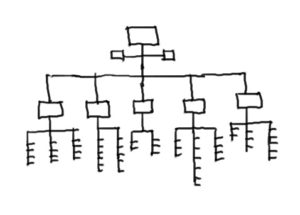The Evils of the Organizational Chart
0 comment

There is an all-too-common, yet harmful, dynamic in nonprofits that I refer to as a hierarchy of importance. Left unchecked, an organization that embraces this hierarchy —by commission or omission—hurts the organization.
I’m not talking about the organizational chart, which, in a visual way, does demonstrate a hierarchy. Left to my own devices, I would do away with organization charts, and come up with another way to demonstrate the one value they do have: showing ascending degrees of responsibility, though not power, and the interconnections, both of which are useful, important and necessary. Or, if there must be an org chart, I would figure out how to do all of this as a single line, demonstrating equal contributions. Neither of these alternatives has happened yet, to a great extent because I’ve not yet gotten to it on my list in Covey’s “important but not urgent” quadrant. Perhaps when I retire.
I have thought, as others have as well, of flipping the org chart, such that the current top becomes the bottom, and the front line staff rises to the top, suggesting, as the top always does, greater importance. But that, too, is the wrong visual, and sends the incorrect message. Obviously, every position in your organization is important and essential to the achievement of mission and overall success of the mission, otherwise why does that position exist? Thus, putting some higher and others lower sends the wrong message. While the message of organization charts offends me intellectually and philosophically, it is not, for most people, considered damaging to the organization. In fact, most people would argue that an org chart is a necessity.
The other hierarchy, however—the hierarchy of importance—is truly damaging, and too often goes unrecognized and, therefore, unchecked. It is a hierarchy perpetrated, sometimes intentionally and sometimes due to ignorance, by program staff. Obviously, not all members of a program staff engage in this behavior, but it is a way more common behavior than it ever should be. Believers in the hierarchy of importance, unfortunately, think that the work they, program staff, do is more important to the organization, and the fulfillment of its mission, than the work of other staff—those who work in finance, development, marketing, IT, etc. This degrading attitude can result in everything from rifts and factions in staff to poor morale and higher turnover. All harmful to the success of the organization.
This hierarchy of importance sees program work as the golden child of the organization and all other staff positions as working to support them, when, in fact, all staff are working for the mission. There isn’t the understanding that in every nonprofit, all of the pieces are equally essential to the delivery of mission and the sustainability of the organization. Development cannot raise funds without successful programs, but successful programs can’t happen without money. How is there a difference of importance there? No programs can take place if money isn’t being carefully tracked so that all times the organization knows how much money is available to do what degree of work. We have seen, time and time again, organizations having to close, regardless of the quality of their programs, because the money wasn’t carefully overseen and stewarded. While the nonprofit sector is late in coming to recognize the importance of marketing to ensure awareness by clients, donors, partners, etc., without any of these people cognizant of the organization, programs won’t happen. The interdependence of all of the pieces of an organization is essential, and the thinking that seeks to elevate some as more important than others is destructive.
The mistakes that this hierarchy creates can often times be seen in the physical offices of nonprofits and in how they do their work. So often, staff working on programs are all clustered together, while the “support” services are all clustered together. This physical layout makes the interconnectivity that should happen in any healthy organization harder to achieve. Individual employee support systems at work aren’t that complicated: affinities tend to spring up within a working group and/or with those whose offices/cubicles are right there. Same meets same: same thinking, same world/organizational view. One experiment I read about had it right when it intentionally made cafeteria lines move slowly so that folks would start up conversations with people they didn’t know who worked in different divisions. They were encouraging that all-important cross-fertilization.
Other consequences can be seen in how an organization works. Too often, when it is time to design a new program, program staff does it all on their own, and only when the design is done, do development and finance get pulled in. And even then it’s more of a mandate to make it happen.
Designing new programs should be a collective effort of program, development, finance, evaluation, and IT/database staff, all working together from the start. In this way, as good division of labor demands, expertise for each piece of the product is brought together to achieve the very best end product. For those who understand the merits of division of labor, there is absolute recognition that the contributions of each skilled laborer doing her/his job is equally vital to the good of the end product; there is acknowledgement that should one piece be missing or done poorly, the whole end product is diminished at best, or fails at worse.
The opinions expressed in Nonprofit University Blog are those of writer and do not necessarily reflect the opinion of La Salle University or any other institution or individual.
